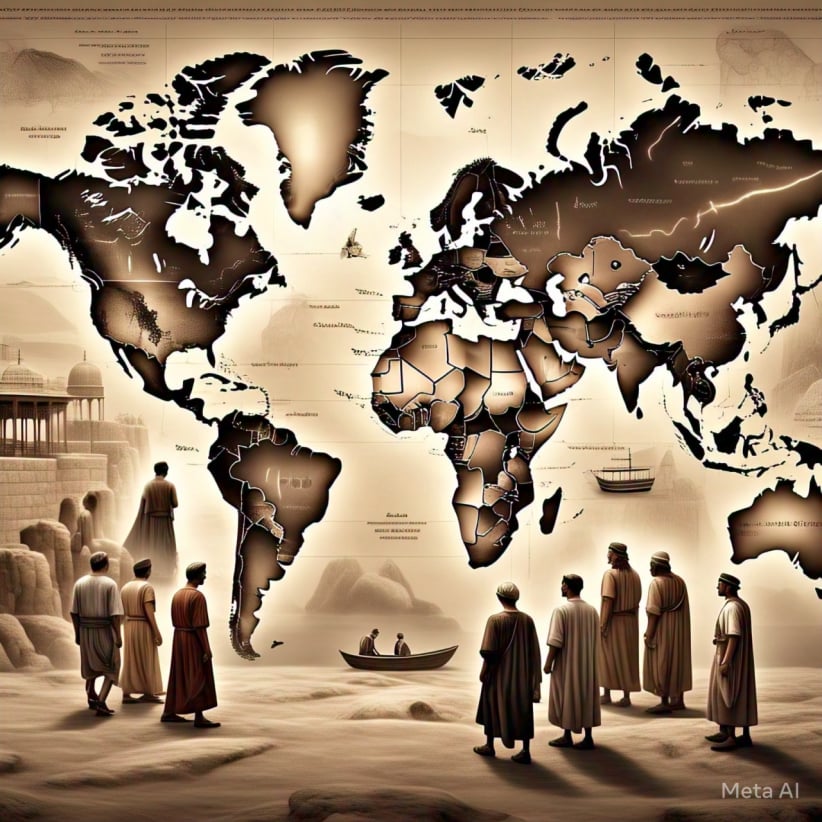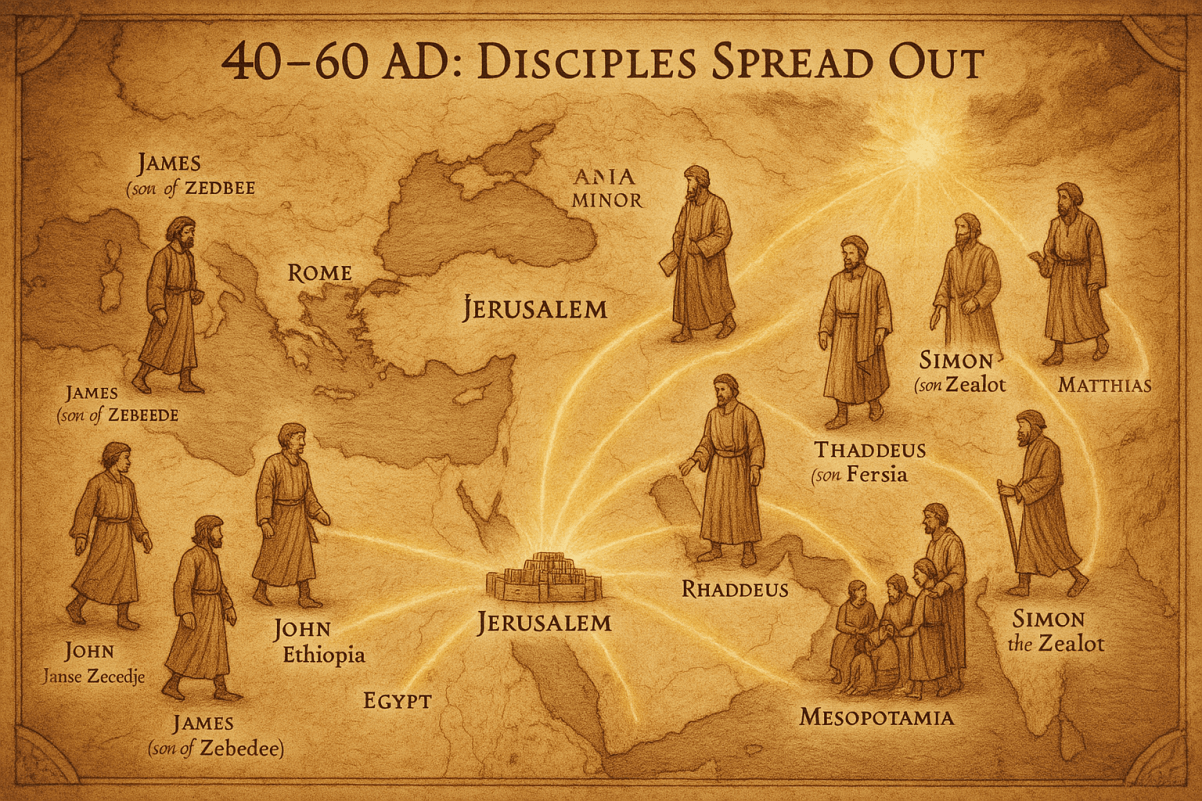

WORK
📜 **The True Apostles Carry the Hebrew Message Beyond Jerusalem**
This was the first wave of *real* gospel expansion—not from Paul, but from the original Twelve chosen by Yeshua (Jesus). After Judas’ betrayal, **Matthias** was chosen as the twelfth—not Paul. Between 36–60 AD, the original Hebrew-Aramaic message of Yeshua went out without Greek interference or Roman corruption.
---
🔥 **What This Timeline Reveals (36–60 AD):**
**✅ The Gospel Was Still Hebrew in Nature**
The message during this time stayed loyal to the **Torah**, the **Prophets**, and the **Kingdom of Yhwh**. No Greek terms. No Roman doctrine. Just truth from the scrolls. The teachings were rooted in the original covenant and spoken in **Hebrew and Aramaic**, not Greek.
**✅ The Original Twelve Were Active**
Yeshua’s eyewitnesses—**Peter, John, Matthew, Thomas, Philip, Bartholomew**, and others—taught what they *saw*, *heard*, and *lived*. These men were raised in Torah and walked with the Messiah. They were not influenced by foreign philosophies.
**✅ Real Expansion, Not a New Religion**
When Yeshua said to go to *Jerusalem, Judea, Samaria, and the ends of the earth*, it was to bring **people back to Yhwh**, not start a new faith. The disciples never taught “Christianity”—they called all people to **repentance, obedience, and mercy through Yhwh**.
**✅ Matthias Replaces Judas—Not Paul**
In Acts 1, **Matthias** was chosen by casting lots, just as the Torah teaches (Proverbs 16:33). This affirms the authority of the original Twelve. Paul was never part of this mission and never accepted by them as one of the Twelve.
**✅ No Church Creeds—Only Hebrew Assemblies**
There was **no Roman Church**, no “Christianity,” and no councils or creeds. Assemblies met in homes and synagogues, honored **biblical feasts**, read the **scrolls**, and lived by **Yhwh’s commandments**. No Trinity, no Sunday worship, no pagan mixtures.
**✅ The Message Went Global—Without Compromise**
* **Thomas**: Went to India
* **Matthew**: Taught in Ethiopia
* **Peter**: Traveled through Asia Minor to Rome
They carried the same message Yeshua gave them. Not Greek philosophy. Not Paul’s doctrine. **They brought the truth of Yhwh to the nations.**
**✅ Persecution Came—But the Truth Endured**
Both **Jewish leaders** and **Roman authorities** tried to stop them. But persecution only deepened their faith. They did not rewrite the message—they preserved it. Many died holding firm to the words they heard from Yeshua Himself.
---
🔚 **Summary:**
From 36–60 AD, there was only one gospel—rooted in **Torah**, **spoken in Hebrew and Aramaic**, taught by the **original disciples**, and pointing people back to **Yhwh alone**. No Greek. No Paul. No church. Just truth.
---
**#TheWayNotChristianity**
**#HebrewRoots**
**#RestoreTheTruth**
**#YeshuaTaughtTorah**
**#3OldBiblesOnly**
**#RejectGreekDoctrine**
**#PaulIsNotOneOfTheTwelve**
**#OriginalGospel**
**#YhwhAloneIsKing**
**#BibleFactsOnline**


WORK
📖 Why Did They Leave Jerusalem? (Around 36–37 AD)
The disciples didn’t leave Jerusalem because they were trying to start a new religion. They left because they were sent, scattered, and in some cases forced out—but all of it fulfilled prophecy and divine purpose.
🔥 1. Persecution Was Rising
By 36–37 AD, the followers of Yeshua faced growing persecution from religious leaders and Roman authorities. Stephen had just been stoned (Acts 7), and many believers were being hunted. This drove many out of Jerusalem—not in fear, but in faithful obedience to YHWH’s call to spread the message.
🕊️ 2. The Spirit Was Leading Them
This was not a random scattering. The Ruach (Spirit of God) was guiding them to go to Judea, Samaria, and to the ends of the earth—just as Yeshua had commanded. The message of the Kingdom was never meant to stay in one place. It had to reach the lost sheep of Israel and the God-fearing Gentiles across the nations.
🌍 3. The Time Was Right for Global Expansion
The Roman roads, Jewish synagogues spread across the empire, and the unrest in Judea all made this the perfect time for the gospel to go global. The disciples were walking into prophecy, bringing the light of truth to places like Syria, Armenia, Egypt, India, and more—long before Paul ever began traveling.
✡️ 4. To Preserve the Hebrew Truth
Before Greek influence took over, before church councils rewrote the faith, these original disciples left Jerusalem to preserve and share the true Hebrew-Aramaic message of Yeshua. They carried it firsthand—unaltered, unfiltered, and full of the authority that only eye-witnesses could bring.
🧭 Where Did Each Disciple Go? (According to earliest sources before 120 AD)
Peter – Preached in Judea, Samaria, Asia Minor (Pontus, Galatia, Cappadocia, Bithynia), and likely reached Rome later in life. His early preaching was mostly to Hebrew-speaking Jews and Aramaic communities.
James (son of Zebedee) – Traveled as far as Spain, preaching in Jewish communities there. He returned to Jerusalem and was executed by Herod Agrippa I around 44 AD.
John (brother of James) – Stayed mostly in Asia Minor (especially Ephesus) but was deeply connected to Jerusalem during the 40s–50s AD. His followers preserved Aramaic teachings, later echoed in his gospel.
Andrew – Preached in Scythia, Greece, and Macedonia. Some early sources suggest he went north of the Black Sea to Jewish communities living in exile.
Philip – Traveled to Phrygia and Syria, especially areas where Aramaic-speaking Jews lived.
Bartholomew (Nathanael) – Took the gospel to India, Mesopotamia, and Armenia, preaching mostly in Hebrew or Aramaic, not Greek.
Thomas (Didymus) – Also journeyed to India, and possibly even further east. The Mar Thoma Church in India traces its roots to him. He is believed to have spoken to Jews in Aramaic and Tamil regions.
Matthew (Levi) – The author of the original Hebrew Gospel of Matthew, he went to Ethiopia, Parthia (Persia), and Syria. His gospel was written to convince Hebrew-speaking Jews that Yeshua was the Messiah.
James (son of Alphaeus) – Preached in Egypt and Persia, staying mostly among Jewish diaspora communities.
Thaddeus (Judas son of James) – Went to Edessa (modern-day Urfa, Turkey), where King Abgar V allegedly became one of the first Christian rulers. Thaddeus is said to have brought Hebrew-Christian teaching to the region.
Simon the Zealot – Traveled through Egypt, Persia, Armenia, and possibly Britain. Focused on Hebrew-speaking Jews in dispersion.
Matthias (replacement for Judas Iscariot) – Preached in Judea, Armenia, and Ethiopia. Remained focused on the Hebrew message.
🕎 Their Message Was Still Hebrew
During this time, their message was not Greekified. It was still rooted in:
Torah obedience
Repentance and righteousness
The Kingdom of God (not heaven as a destination, but God’s rule on earth)
Yeshua as the promised Messiah
The expectation of a soon-coming restoration of Israel
They did not teach original sin, Greek dualism, or the idea that Torah was abolished. That would come later through others.
⚔️ Conflict Was Already Rising By the late 45s - 60s AD?
By the late 45s to 60s AD, Paul and Luke were laying the foundation for a radically different gospel message—one that shifted away from Hebrew tradition and toward a Hellenized version more palatable to the Greek-speaking world. While the original Twelve disciples were still preaching repentance and obedience to the Torah, Paul and Luke were moving in a separate direction—a direction that would eventually create conflict with the teachings of the Jerusalem assembly.
⚠️ What Was Paul Doing (45–60 AD)?
Paul (formerly Saul of Tarsus) claimed to have had a vision of Yeshua around 44–45AD, but his influence only began to grow in the 40s AD. His teachings, missions, and writings during this time played a key role in separating his movement from the original Hebrew disciples.
🧭 Paul's Activity in This Period:
44–45 AD – Stayed in Antioch, with brief visits to Jerusalem.
46–49 AD – First "missionary journey" (Galatia, Cyprus, Pisidia). Preached directly to Gentiles and bypassed the Torah.
50–52 AD – Second journey (Macedonia, Greece – Thessalonica, Corinth). Formed house churches among Greek converts.
53–57 AD – Third journey (Ephesus, Asia Minor). Influence expanded. Began writing letters (e.g., Galatians, Corinthians, Romans).
Late 50s – Returned to Jerusalem and was arrested.
📜 What Was Paul Teaching?
Claimed he received his gospel “not from man, but by revelation” (Galatians 1:12).
Argued that Gentiles could be saved without Torah, circumcision, or any connection to Jewish identity.
Promoted a spiritualized doctrine of sin, law, and grace—rooted more in Greek dualism than Hebrew thought.
Declared that “Christ is the end of the law” (Romans 10:4), directly contradicting Yeshua’s words in Matthew 5:17.
Paul’s letters from this time reflect increasing conflict with the original Twelve—especially James, Peter, and John.
🚨 Key Conflicts:
Galatians 2 – Paul rebukes Peter publicly for eating with Gentiles—clear division between the camps.
Acts 15 (Jerusalem Council) – Paul presents this as a victory for his view, but the Twelve only issued temporary instructions for new Gentile believers.
James (the brother of Yeshua) taught Torah, righteousness, and works—in direct opposition to Paul’s letters.
🧑⚕️ What Was Luke Doing (40–60 AD)?
Luke, believed to be a Greek physician and Paul’s close companion, never met Yeshua and had no connection to the early Hebrew assembly in Jerusalem.
✍️ During this time:
Traveled with Paul and served as his scribe and storyteller.
Later wrote:
The Gospel of Luke (likely after 60 AD)
Acts of the Apostles (also post-60 AD)
Both writings portray Paul as the central figure and minimize the role of the original Twelve. Luke’s accounts often conflict with Hebrew sources and early traditions.
⚠️ Problems with Luke’s Writings:
Acts contradicts Paul’s own letters (e.g., multiple versions of Paul’s conversion – Acts 9, 22, and 26).
The narrative shifts away from Jerusalem and the Hebrew disciples, building Paul as the main hero.
Early Hebrew believers often rejected Luke's Gospel and Acts as biased and misaligned with the teachings of Yeshua and the Twelve.
There was a growing tension between the Torah-faithful emissaries of Yeshua and the emerging Greek-philosophical gospel promoted by Paul and Luke. What began in this period would eventually lead to a full split—and the rise of a different version of Christianity.
Summary of 40–60 AD:
The original disciples of Yeshua spread out from Jerusalem to every corner of the known world.
Their message remained Hebrew, Torah-rooted, and focused on the Kingdom.
They spoke in Hebrew and Aramaic, not Greek.
They built communities, not empires.
Their writings and teachings were later suppressed or replaced by the Roman Church’s version of Christianity.